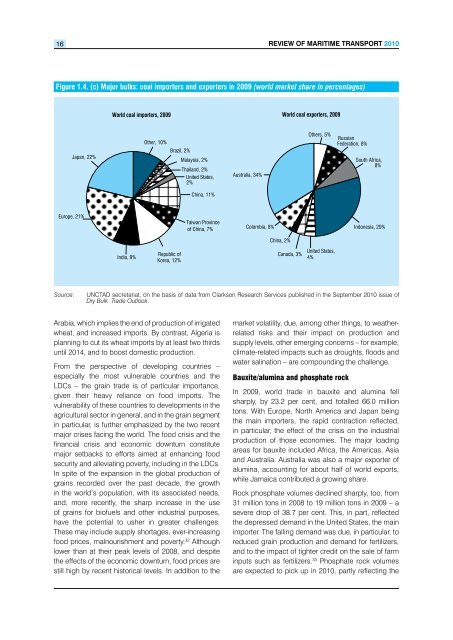Review of Maritime Transport 2010 - Unctad
Review of Maritime Transport 2010 - Unctad
Review of Maritime Transport 2010 - Unctad
You also want an ePaper? Increase the reach of your titles
YUMPU automatically turns print PDFs into web optimized ePapers that Google loves.
16<br />
<strong>Review</strong> <strong>of</strong> MaRitiMe tRanspoRt <strong>2010</strong><br />
Figure 1.4. (c) Major bulks: coal importers and exporters in 2009 (world market share in percentages)<br />
Japan, 22%<br />
Europe, 21%<br />
World coal importers, 2009<br />
India, 9%<br />
Other, 10%<br />
Brazil, 2%<br />
Republic <strong>of</strong><br />
Korea, 12%<br />
Malaysia, 2%<br />
Thailand, 2%<br />
United States,<br />
2%<br />
China, 11%<br />
Taiwan Province<br />
<strong>of</strong> China, 7%<br />
Australia, 34%<br />
Colombia, 8%<br />
China, 2%<br />
World coal exporters, 2009<br />
Canada, 3%<br />
Others, 5%<br />
United States,<br />
4%<br />
Russian<br />
Federation, 8%<br />
South Africa,<br />
8%<br />
Indonesia, 29%<br />
Source: UNCTAD secretariat, on the basis <strong>of</strong> data from Clarkson Research Services published in the September <strong>2010</strong> issue <strong>of</strong><br />
Dry Bulk Trade Outlook.<br />
Arabia, which implies the end <strong>of</strong> production <strong>of</strong> irrigated<br />
wheat, and increased imports. By contrast, Algeria is<br />
planning to cut its wheat imports by at least two thirds<br />
until 2014, and to boost domestic production.<br />
From the perspective <strong>of</strong> developing countries –<br />
especially the most vulnerable countries and the<br />
LDCs – the grain trade is <strong>of</strong> particular importance,<br />
given their heavy reliance on food imports. The<br />
vulnerability <strong>of</strong> these countries to developments in the<br />
agricultural sector in general, and in the grain segment<br />
in particular, is further emphasized by the two recent<br />
major crises facing the world. The food crisis and the<br />
financial crisis and economic downturn constitute<br />
major setbacks to efforts aimed at enhancing food<br />
security and alleviating poverty, including in the LDCs.<br />
In spite <strong>of</strong> the expansion in the global production <strong>of</strong><br />
grains recorded over the past decade, the growth<br />
in the world’s population, with its associated needs,<br />
and, more recently, the sharp increase in the use<br />
<strong>of</strong> grains for bi<strong>of</strong>uels and other industrial purposes,<br />
have the potential to usher in greater challenges.<br />
These may include supply shortages, ever-increasing<br />
food prices, malnourishment and poverty. 32 Although<br />
lower than at their peak levels <strong>of</strong> 2008, and despite<br />
the effects <strong>of</strong> the economic downturn, food prices are<br />
still high by recent historical levels. In addition to the<br />
market volatility, due, among other things, to weatherrelated<br />
risks and their impact on production and<br />
supply levels, other emerging concerns – for example,<br />
climate-related impacts such as droughts, floods and<br />
water salination – are compounding the challenge.<br />
Bauxite/alumina and phosphate rock<br />
In 2009, world trade in bauxite and alumina fell<br />
sharply, by 23.2 per cent, and totalled 66.0 million<br />
tons. With Europe, North America and Japan being<br />
the main importers, the rapid contraction reflected,<br />
in particular, the effect <strong>of</strong> the crisis on the industrial<br />
production <strong>of</strong> those economies. The major loading<br />
areas for bauxite included Africa, the Americas, Asia<br />
and Australia. Australia was also a major exporter <strong>of</strong><br />
alumina, accounting for about half <strong>of</strong> world exports,<br />
while Jamaica contributed a growing share.<br />
Rock phosphate volumes declined sharply, too, from<br />
31 million tons in 2008 to 19 million tons in 2009 – a<br />
severe drop <strong>of</strong> 38.7 per cent. This, in part, reflected<br />
the depressed demand in the United States, the main<br />
importer. The falling demand was due, in particular, to<br />
reduced grain production and demand for fertilizers,<br />
and to the impact <strong>of</strong> tighter credit on the sale <strong>of</strong> farm<br />
inputs such as fertilizers. 33 Phosphate rock volumes<br />
are expected to pick up in <strong>2010</strong>, partly reflecting the

















